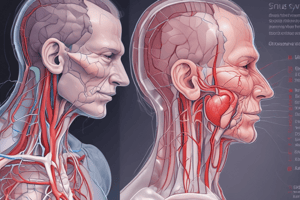Podcast
Questions and Answers
What role do K+ protein channels play in cardiac cells?
What role do K+ protein channels play in cardiac cells?
Which type of channel helps cardiac pacemaker cells reach threshold at the end of phase 4?
Which type of channel helps cardiac pacemaker cells reach threshold at the end of phase 4?
Which channel is NOT involved in the depolarization of cardiac pacemaker cells?
Which channel is NOT involved in the depolarization of cardiac pacemaker cells?
What is the consequence of K+ protein channel activity during cardiac action potentials?
What is the consequence of K+ protein channel activity during cardiac action potentials?
Signup and view all the answers
Which of the following statements about channel functions in cardiac cells is correct?
Which of the following statements about channel functions in cardiac cells is correct?
Signup and view all the answers
What defines sinus bradycardia?
What defines sinus bradycardia?
Signup and view all the answers
What is the role of cyclic nucleotide-gated 'funny' cation channels in the heart?
What is the role of cyclic nucleotide-gated 'funny' cation channels in the heart?
Signup and view all the answers
Which of the following can cause sinus bradycardia?
Which of the following can cause sinus bradycardia?
Signup and view all the answers
How is heart rate primarily regulated in the human body?
How is heart rate primarily regulated in the human body?
Signup and view all the answers
Which mechanisms help maintain the resting membrane potential in cardiac pacemaker cells?
Which mechanisms help maintain the resting membrane potential in cardiac pacemaker cells?
Signup and view all the answers
What is one potential cause of sinus bradycardia in healthy individuals?
What is one potential cause of sinus bradycardia in healthy individuals?
Signup and view all the answers
What is primarily affected in pathological causes of sinus bradycardia?
What is primarily affected in pathological causes of sinus bradycardia?
Signup and view all the answers
What is the main effect of L-type Ca2+ channels during action potentials in cardiac cells?
What is the main effect of L-type Ca2+ channels during action potentials in cardiac cells?
Signup and view all the answers
Study Notes
Sinus Bradycardia
- Sinus bradycardia is a heart rate of less than 60 beats per minute.
- Sinus bradycardia can be normal in well-conditioned athletes and older individuals.
- Sinus bradycardia can also be caused by medications or SA node disease.
- It can be seen in healthy subjects who are well conditioned (runners),
- It can be caused by medication such as beta-blockers, clonidine, opioids, and parasympathetic agonists.
- The heart rate is determined by the SA node (Sinoatrial node).
- The rate is determined by the activity of cyclic nucleotide-gated “funny” cation channels.
- “Funny” cation channels control Na+ membrane permeability, moving the resting membrane potential closer to threshold during phase 4.
Cardiac Pacemaker Cells
- Cardiac pacemaker cells are responsible for automaticity (spontaneous depolarization).
- The SA node is made up of cardiac pacemaker cells.
- “L” type Ca2+ channels open during an action potential (depolarization).
- K+ protein channels are responsible for membrane repolarization.
- Transient “T” type Ca2+ channels move the cardiac pacemaker cells closer to threshold at the end of phase 4.
Cardiac myocyte cells
- Fast voltage-gated Na+ channels determine the depolarization of cardiac myocytes (non-pacemaker) cells.
Studying That Suits You
Use AI to generate personalized quizzes and flashcards to suit your learning preferences.
Description
Test your knowledge on sinus bradycardia and cardiac pacemaker cells. This quiz covers the physiological aspects of heart rate, the role of the SA node, and the factors affecting bradycardia. Perfect for students studying cardiovascular physiology.




